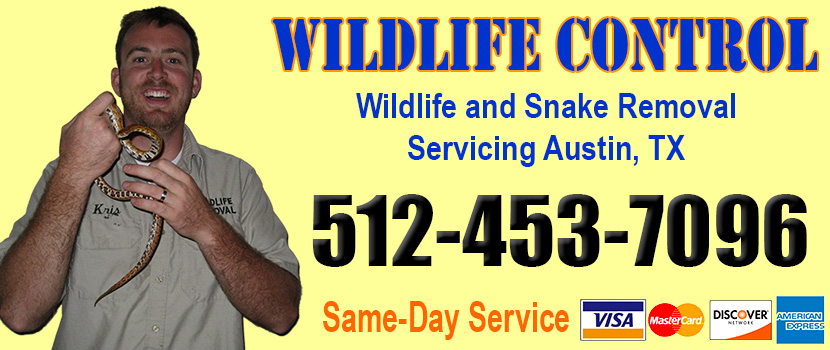
Welcome to austinsnakes.com! I am David, a snake enthusiast living in Austin, TX. Many people don't know that Austin is in fact full of snakes! You just need to know where to find them - they can often be shy and elusive. Some Texas snake species are more common outside of the city limits, in different parts of Travis County TX, but many types of snakes are indeed common in the more urban parts of Austin. This guide is meant to help educate you about the beautiful snakes of Austin, and to help you identify the most common snakes of Austin, as well as the venomous snakes of Austin that you should learn to recognize and avoid. If you want more detail, click here for my complete list of ALL snake species in Austin. Remember the following:
- Most snakes of Austin are harmless and don't want to encounter you
- Venomous snakes exist but are uncommon in Austin, Texas
- Snakes eat rats and mice and are a valuable part of the Texas ecosystem
- Never kill a snake - if you leave a snake alone, it will leave you alone.
Common Snake Species in Austin
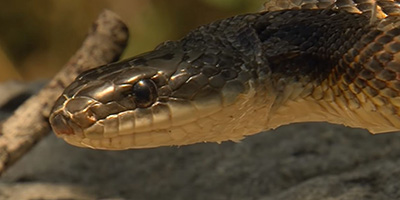 Texas rat snake:
This may be the most abundant snake in Texas as a whole. Texas rat snakes are good climbers that feed mainly on mice, birds and their eggs, and rats. Although it can grow really large and can be intimidating when sighted, it is non-venomous and not dangerous to humans. If cornered, it will bite but the bite is not venomous. It also produces an extremely unpleasant smell which it uses to protect itself from predators.
Texas rat snake:
This may be the most abundant snake in Texas as a whole. Texas rat snakes are good climbers that feed mainly on mice, birds and their eggs, and rats. Although it can grow really large and can be intimidating when sighted, it is non-venomous and not dangerous to humans. If cornered, it will bite but the bite is not venomous. It also produces an extremely unpleasant smell which it uses to protect itself from predators. 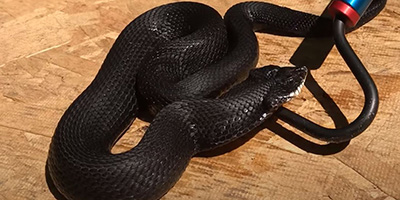 Hog-nosed snake:
These snakes mimic rattlesnakes and can be easily mistaken for one. Just like a rattlesnake, it will curl up and raise the sides of its head. Hog-nosed snakes, however, do not possess venom glands or even rattles possessed by rattlesnakes. When threatened, hog-nosed snakes will play dead by lying upside down, sometimes defecating or vomiting.
Hog-nosed snake:
These snakes mimic rattlesnakes and can be easily mistaken for one. Just like a rattlesnake, it will curl up and raise the sides of its head. Hog-nosed snakes, however, do not possess venom glands or even rattles possessed by rattlesnakes. When threatened, hog-nosed snakes will play dead by lying upside down, sometimes defecating or vomiting. 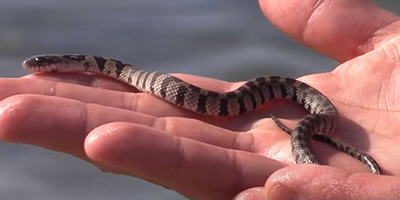 Water snake:
Water snakes behave like venomous cottonmouth snakes and some species even resemble them. They spend a lot of time inside ponds, streams, and water bodies generally. Many water snake species can be found in Austin such as diamond-backed water snakes (Nerodia rhombifer), plain-bellied water snakes, banded and un-banded water snakes, and so on. All species possess dark vertical lines that span the entire lower jaw. Unlike cottonmouths with distinctly long necks, water snakes' necks are not easily distinguishable from their heads. Although not venomous, water snakes can deliver a very painful bite when threatened.
Water snake:
Water snakes behave like venomous cottonmouth snakes and some species even resemble them. They spend a lot of time inside ponds, streams, and water bodies generally. Many water snake species can be found in Austin such as diamond-backed water snakes (Nerodia rhombifer), plain-bellied water snakes, banded and un-banded water snakes, and so on. All species possess dark vertical lines that span the entire lower jaw. Unlike cottonmouths with distinctly long necks, water snakes' necks are not easily distinguishable from their heads. Although not venomous, water snakes can deliver a very painful bite when threatened. Venomous Snake Species in Austin
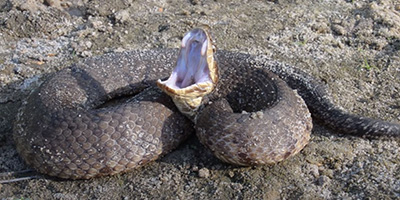 Cottonmouth or water moccasin:
Cottonmouths are generally water-habiting snakes. They can mostly be found in ponds, rivers, streams, swamps, and so on. At about 3.5 inches in length, cottonmouths are not easily spotted. They come in a variety of colors such as black, olive green, or brown. They have large dark bands which may be more visible in some species than others. The cottonmouth earned its name as a result of the white cotton-like tissue it produces from its mouth when threatened. They are venomous snakes that may cause death if they bite humans or pets.
Cottonmouth or water moccasin:
Cottonmouths are generally water-habiting snakes. They can mostly be found in ponds, rivers, streams, swamps, and so on. At about 3.5 inches in length, cottonmouths are not easily spotted. They come in a variety of colors such as black, olive green, or brown. They have large dark bands which may be more visible in some species than others. The cottonmouth earned its name as a result of the white cotton-like tissue it produces from its mouth when threatened. They are venomous snakes that may cause death if they bite humans or pets.  Copperhead:
Copperheads earned their name from their reddish-brown crossbands arranged on a lighter colored body. They may be found near water bodies but they are typically found in rocky environments and areas covered by weeds. This snake can grow up to 30 inches in length.
Broad-banded copperhead species are often common in Austin, although other species can be found too. The broadband copperhead is relatively long and can reach up to 3 feet in length. Copperheads are said to have hemotoxic venom. This means that a bite from a copperhead snake may cause tissue damage. Although a bite from this snake may be fatal, copperheads rarely inject a large amount of venom into their prey, this gives a better chance of surviving the bite.
Copperhead:
Copperheads earned their name from their reddish-brown crossbands arranged on a lighter colored body. They may be found near water bodies but they are typically found in rocky environments and areas covered by weeds. This snake can grow up to 30 inches in length.
Broad-banded copperhead species are often common in Austin, although other species can be found too. The broadband copperhead is relatively long and can reach up to 3 feet in length. Copperheads are said to have hemotoxic venom. This means that a bite from a copperhead snake may cause tissue damage. Although a bite from this snake may be fatal, copperheads rarely inject a large amount of venom into their prey, this gives a better chance of surviving the bite.
 Rattlesnake:
Throughout Texas, 6 species of rattlesnakes are common. Rattlesnakes can vary in size and color depending on the species. Their distinguishing factor is the rattle at the end of their tail. The rattle makes a loud sound just like a rattle that is being shaken as a warning sign when the snake is threatened. Rattlesnake bites are some of the most frequent snake bites reported in North America. However, the snake does not just attack. It will instead rattle its tail at the intruder before moving to strike as a last resort.
Rattlesnake:
Throughout Texas, 6 species of rattlesnakes are common. Rattlesnakes can vary in size and color depending on the species. Their distinguishing factor is the rattle at the end of their tail. The rattle makes a loud sound just like a rattle that is being shaken as a warning sign when the snake is threatened. Rattlesnake bites are some of the most frequent snake bites reported in North America. However, the snake does not just attack. It will instead rattle its tail at the intruder before moving to strike as a last resort. 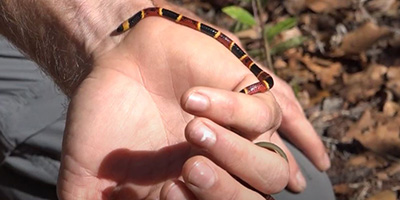 Coral snake:
Coral snakes belong to the Cobra family. They are usually not aggressive like pit vipers such as rattlesnakes but they have very venomous poison. They are brightly colored snakes with a broad black ring, a yellow ring, and then a broad red ring alternating on their bodies. Many snakes closely resemble the coral snake, however, they are the only species with the yellow and red band touching each other. Although very poisonous, coral snakes have a poor poison delivery system as they have weak fangs and have to hold on to prey for a long time before the poison can be delivered.
Coral snake:
Coral snakes belong to the Cobra family. They are usually not aggressive like pit vipers such as rattlesnakes but they have very venomous poison. They are brightly colored snakes with a broad black ring, a yellow ring, and then a broad red ring alternating on their bodies. Many snakes closely resemble the coral snake, however, they are the only species with the yellow and red band touching each other. Although very poisonous, coral snakes have a poor poison delivery system as they have weak fangs and have to hold on to prey for a long time before the poison can be delivered.If you're unsure, you can email me a photo of the snake at info@austinsnakes.com and I will email you back with the snake's species. If you found a snake skin, read my Found a Skin? page, and you can email me a photo of the skin, and I'll identify the snake for you. If you need professional Austin snake removal help, click my Get Help page, or see the below website sponsor I found, who provides that service.
Understanding The Yellow Rat Snake: Appearance, Biology, Life Cycle, Habitat, Diet, Behavior
A common snake for those who live on the east coast, the yellow rat snake is a non-lethal type of snake that typically stays away from humans. You can find it in many areas and have likely seen it at some point. Whether you fear snakes or not, understanding more about it can help you if you see it in the future. As with any other animal, there are important facts about it. To keep you safe and to keep the snake safe, you should know more about it. Everything from its appearance to its reproduction is an important piece of your safety and its safety.
Appearance
Yellow rat snakes are yellow – obviously. They grow to, at most, 6 feet long, though they may be shorter, and are yellow with some black stripes going down the back.
Life
Like other rat snakes, the yellow rat snake mates in spring and will lay eggs a few weeks later. The eggs will take about 2 months to hatch after that. The baby snakes will be on their own after hatching. Rat snakes do not care for their young, nor do their young need it. They are ready to go live on their own immediately. These snakes can live up to two decades about, though wild snakes typically do not live that long.
Behavior
Slightly more aggressive than other rat snakes, yellow rat snakes may bite when threatened. However, they are not going to go after you. Most snakes are not going to do that. They prefer to stay away from humans. They are slightly more aggressive, and will attack if cornered, though.
Habitat
You can usually find yellow rat snakes around oak trees and swamps and forests. You can find them in most places that offer adequate shelter across the Carolinas to Florida. They like everything from the Everglades to abandoned structures. If it offers shelter, they want it.
Diet
Rats are a major part of the diet for a rat snake. They will capture, constrict, and consume rats and other rodents generally. They may also go after birds, lizards, eggs, and similar prey. Yellow rat snakes are typical for rat snakes. Found on the east coast, these snakes are common wherever they live. You can find them anywhere from your backyard to a swamp – and likely have if you live in the same areas as them.
Remember, the term is not poisonous snakes of Austin, it's venomous snakes of Austin. Poison is generally something you eat, and venom is injected into you. That said, dangerous snakes are very rare in Austin. The few venomous snakes of Travis County are rarely seen. But they are commonly misidentified, so learn about all the snake species of Austin in order to correctly identify them. These snakes are usually also found in the surrounding towns of Pflugerville, Lakeway, Lago Vista, Del Valle , Bee Cave, Manor, West Lake Hills, Volente, Rollingwood, Manchaca, Jonestown, Point Venture, Hudson Bend, Sunset Valley, The Hills, Briarcliff, Creedmoor, Webberville, Barton Creek, Wells Branch, Hornsby Bend, Windemere, San Leanna, Garfield, Lost Creek and the surrounding areas.
Read our article about:
Understanding The Water Moccasin Snake: Appearance, Biology, Life Cycle, Habitat, Diet, Behavior
austinsnakes.com domain and hosting costs made possible by the generous support of this sponsor:
